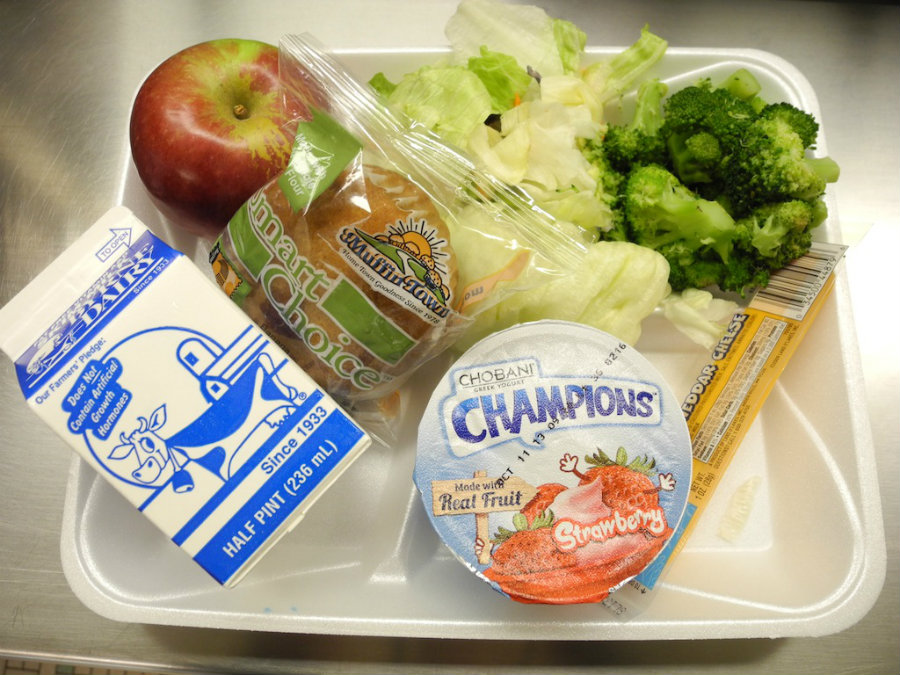The U.S. Department of Agriculture (USDA) announced Monday new guidelines for school meal programs, discarding the previous program implemented by the Obama administration. U.S. Secretary of Agriculture Sonny Perdue announced greater flexibility in nutrition requirements for school lunch programs during a visit to Catoctin Elementary School in Leesburg, Virginia.
The USDA will diminish implementation of stricter sodium standards and will continue to allow exemptions on 100% whole grain compliance. Perdue also announced that 1% milk would be allowed again in schools, as currently only non-fat flavored milk is permitted into school cafeterias.

Nutrition standards for schools were mandated in 2010 with the passage of the Healthy, Hunger-Free Kids Act, which was strongly supported by Michelle Obama. Around 31 million students eat school lunch daily, and 15 million students eat school breakfast every day.
USDA new guidelines shift from Obama-era healthy meals program
According to Perdue, the new guidelines will make food choices both healthful and appealing to students, and the Secretary signed a proclamation to begin the process of restoring local control of guidelines on sodium, whole grains, and milk.
“This announcement is the result of years of feedback from students, schools, and food service experts about the challenges they are facing in meeting the final regulations for school meals,” said Perdue, according to a statement from the USDA. “If kids aren’t eating the food, and it’s ending up in the trash, they aren’t getting any nutrition – thus undermining the intent of the program.”
Patricia Montague, CEO of the School Nutrition Association, joined Perdue in the announcement and said she commended Secretary Perdue for taking such an important step. Montague added that they had wanted flexibility for a while so that schools can serve meals that are both nutritious and palatable, and that they don’t want kids wasting their meals by throwing them away. She noted that some of their schools are using that food waste as compost and that it shouldn’t be happening.
According to the USDA, schools have been facing increasing fiscal burdens as they try to adhere to existing food requirements, and they estimate that such requirements cost school districts and states $1.22 billion in Fiscal Year 2015. While such costs are going up, several states are reporting that they’ve seen a decrease in student participation in school lunches, as over 1 million students choose not to have a school lunch every day, said the USDA. Both things have an impact on the school, as the decline in school lunch participation means reduced revenue to schools while they also face increasing costs.
Perdue said that he talked to “folks” at Washington that told him the current program worked, as 99 percent of schools were partially complying with the guidelines. However, he believes that Washington may be the only state where the program worked as intended. He cited as an example southern schools, where they want to serve grits, but the whole grain variety has small black flakes in it, and the kids won’t eat it. He noted that the schools are compliant with the whole grain requirements, but the kids aren’t eating the grits, and it doesn’t make any sense.

New flexibility with whole grain, sodium and milk requirements
There are several new changes to be implemented in schools regarding whole grains, sodium, and milk. The USDA said schools are experiencing challenges in finding the full range of products of whole grain they need and that their students enjoy in whole grain-rich form. As a way to provide flexibility to schools, the USDA will allow states to grant exemptions to schools experiencing hardship in serving 100 percent of grain products as whole-grain rich for the academic year 2017-2018. The Department added it will take necessary regulatory actions to implement a long-term solution.
In the sodium requirements, USDA noted that for school years 2017 to 2020, schools will not be required to meet Sodium Target 2 and that Sodium Target 1 will be considered compliant. In this time frame, the USDA expects schools will be able to implement food plans with the appropriate amount of sodium, and that USDA said it will provide resources to schools to develop menus that are low in sodium and appealing to students. Currently, school lunches in elementary schools must have no more than 1,230 mg of sodium, and Perdue’s new guidelines maintain that level.
Milk is a major component of school meals, and the USDA believes that schools should offer a wider range of milk flavors, which is why they will allow back 1% flavored milk in school cafeterias.
“I’ve got 14 grandchildren, and there is no way that I would propose something if I didn’t think it was good, healthful, and the right thing to do,” said Perdue. “And here’s the thing about local control: it means that this new flexibility will give schools and states the option of doing what we’re laying out here today. These are not mandates on schools.”
The USDA estimates 97 percent of schools have implemented the healthy school nutrition standards. Research published in January 2016, found that the implementation of the healthy school meal guidelines was associated with improvement in the nutritional quality of meals selected by students, driven by the increase in variety, portion, and the number of servings of vegetables and fruits.
Source: USDA
